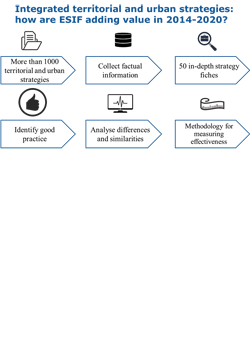Integrated territorial and urban strategies: how are ESIF adding value in 2014-2020?

Studies
Date: 21 dec 2017
Period: 2014-2020
Theme: Environment, Urban development, Social inclusion, Jobs, Education and Training
Languages: en
The 2014-2020 regulatory provisions to EU Cohesion policy gave Member States new opportunities to use ESIF for sustainable urban development and other territorial strategies, particularly using Integrated Territorial Investment. This study examines how Member States are responding to these new provisions and how Cohesion policy is ‘adding value’ to regional, urban and local development.
The study shows that there has been significant uptake of territorial strategies in 2014-2020, mainly in the form of sustainable urban development, across most Member States. Many of the strategies are new; the territorial provisions have encouraged innovation and adaptation in both thinking and practice. This innovation includes a more integrated approach to intervention, the implementation of strategies at different spatial scales, and more collaborative models of governance.
There is scope for extending the use of territorial strategies in future, albeit with simplification of some of the regulatory requirements and more flexibility in programming. There is a need for institutional capacity-building to ensure efficient implementation at local level and greater emphasis on citizen engagement. Lastly, more attention needs to be given to monitoring and evaluating the outcomes of strategies.
